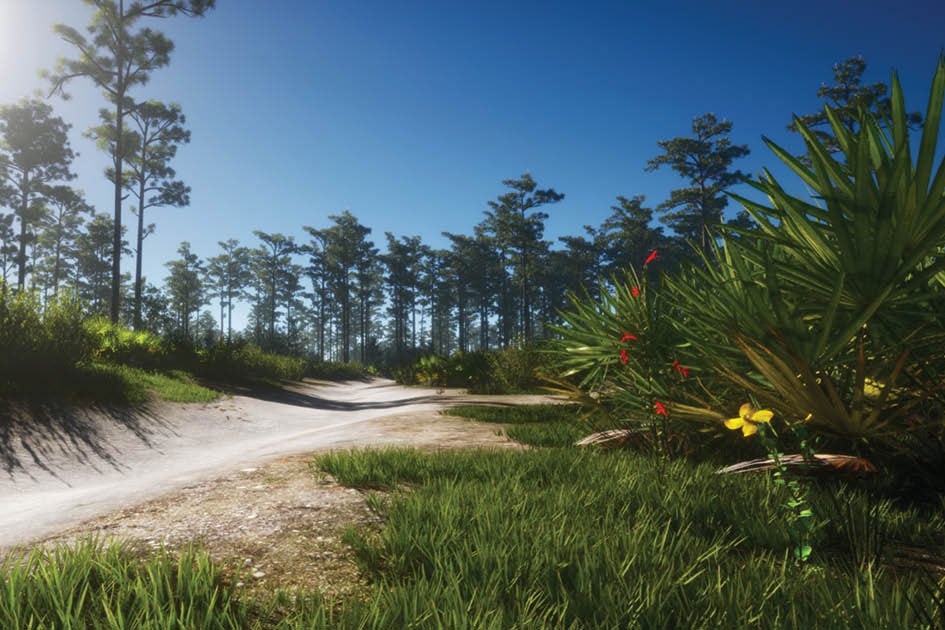Under the direction of Maria Harrington, the Harrington Lab at UCF investigates virtual nature, using AR and VR as a technical artifact, to better understand perceptual phenomenon as it relates to human-computing-environment interactions that cause emotional, learning and aesthetic outcomes. The lab is highly collaborative with several active multidisciplinary partnerships.
“Experiencing the natural world inspires awe, wonder and curiosity. This is how we learned until relatively recently in the modern world,” Harrington says. “We can design tools intentionally to support that intrinsic desire to explore, discover and learn in very natural ways, and connect to something very deep in our evolutionary brains from over 200,000 years of human-environment interactions.”
Recently, Harrington presented her work at I/ITSEC 2022. Her presentation — titled “Immersive Embodied Digital Twins of Nature and the Role of Information Fidelity in Knowledge Acquisition” — is about two products developed as digital twins of nature using geospatial datasets, visualized in immersive AR and VR devices, and used in IRB-approved research studies on learning impacts.
In 2015, Harrington and a team of students developed the AR Perpetual Garden app in collaboration with the Carnegie Museum of Natural History to modernize the museum’s dioramas. Through photorealistic 3D models and ambient sounds, museumgoers can learn about balanced and unbalanced woodland ecosystems and how they impact deer populations.
Harrington also studied the impact of the immersive experience versus a printed pamphlet. While both methods yielded learning gains of 40% in 10 minutes, the virtual experience produced more positive associations with the beauty of plant life, which led users to make stronger connections to the information around these objects.
“The power of these immersive tools is that they create highly salient emotional experiences and episodic memories that are anchoring in your mind,” Harrington says.
Under the direction of Maria Harrington, the Harrington Lab at UCF investigates virtual nature, using AR and VR as a technical artifact, to better understand perceptual phenomenon as it relates to human-computing-environment interactions that cause emotional, learning and aesthetic outcomes. The lab is highly collaborative with several active multidisciplinary partnerships.
“There’s an innately human desire to understand the natural world and to seek knowledge, and can we design tools intentionally to support that intrinsic desire to learn in very natural ways,” Harrington says.
To make the greatest impact, cartoon-like imagery won’t cut it, she notes. High-fidelity graphics are needed to provide realistic models that enhance the information people interpret and replicate real-life experiences.
In recent years, Harrington developed the Virtual Arboretum, which allows people to experience the actual UCF Arboretum, through cutting-edge AR and VR technology. From schoolchildren to botanists, users can download and access the experience on any game or VR-ready PC to explore 247 acres of unspoiled Florida habitat with replications of plants native to the Southeast.
“The natural world is really the highest-level structure in STEM curriculum because it’s physics, it’s chemistry, it’s biology and it’s mathematics,” Harrington says. “But by making those hard science subjects accessible through a field trip, [and even more accessible through a virtual one], it’s an incredibly natural way to learn because we all wish to understand our world.”
Harrington’s work on the Virtual Arboretum has received national and international recognition. Multimedia giant Epic Games awarded Harrington a $25,000 grant to explore new techniques to improve the experience and to potentially broaden the collection to initially include botanical gardens and university arboretums from the American Southwest and Pacific Northwest.
MuseWeb also selected the work as a finalist for its GLAMi Awards. The international honor recognizes the best innovative projects in the cultural heritage sector that engages, informs and excites the public. Some of the others in the competition included the Smithsonian and the Metropolitan Museum of Art.
In the future, she hopes to integrate digital twins of nature with man-made digital twins to enhance the real world.
“I think we are living in environments that are very hostile, from a sensory-field perspective — not very beautiful and very unnatural. Our sensitivity as organisms in [these] urban environments is largely ignored,” Harrington says. “Digital twins could help us simulate city planning and integrate sustainable urban landscape design to make cityscapes more beautiful and healthier environments for people to thrive, learn and grow in. I think the economic dimension is very important, which digital twin can calculate.”




